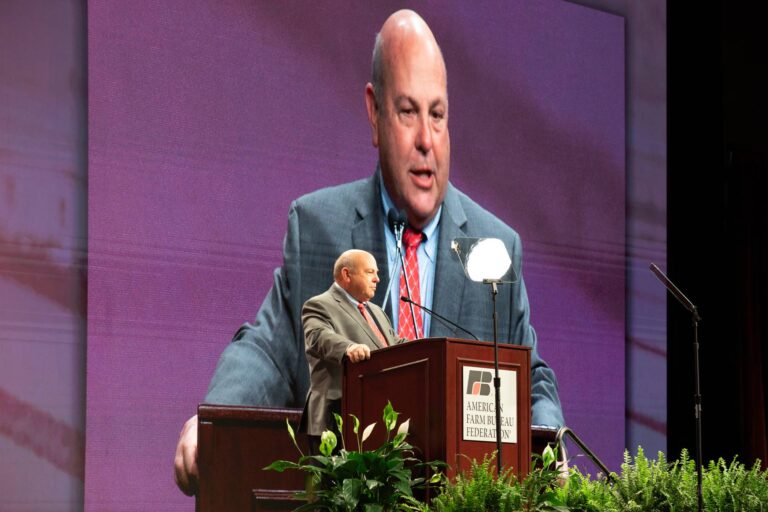This story is a collaboration between Investigate Midwest and Watchdog Writers Group.
The newsrooms are continuing to cover Farm Bureaus and their influence. Is there an aspect of the Farm Bureau you think is underreported or not getting enough attention? Please contact Sky Chadde, sky.chadde@investigatemidwest.org, or Madison McVan, madison.mcvan@investigatemidwest.org.
The American Farm Bureau Federation calls itself the “Voice of Agriculture,” a slogan it trademarked in 2007. But as the divide between agribusiness and small farmers has grown in recent decades, a unified voice of agriculture has become harder to achieve.
Some farming groups have formed in opposition to the AFBF, accusing it of lobbying against the interests of small farmers. The growing political divide could help define the future of agriculture in America.
Part of the divide was on display in early January, as hundreds of farmers gathered in a cavernous room at the AFBF annual conference in Atlanta. Their votes would determine the direction of the agricultural organization’s policy — contained in the 2022 Policy Book — in the upcoming year.
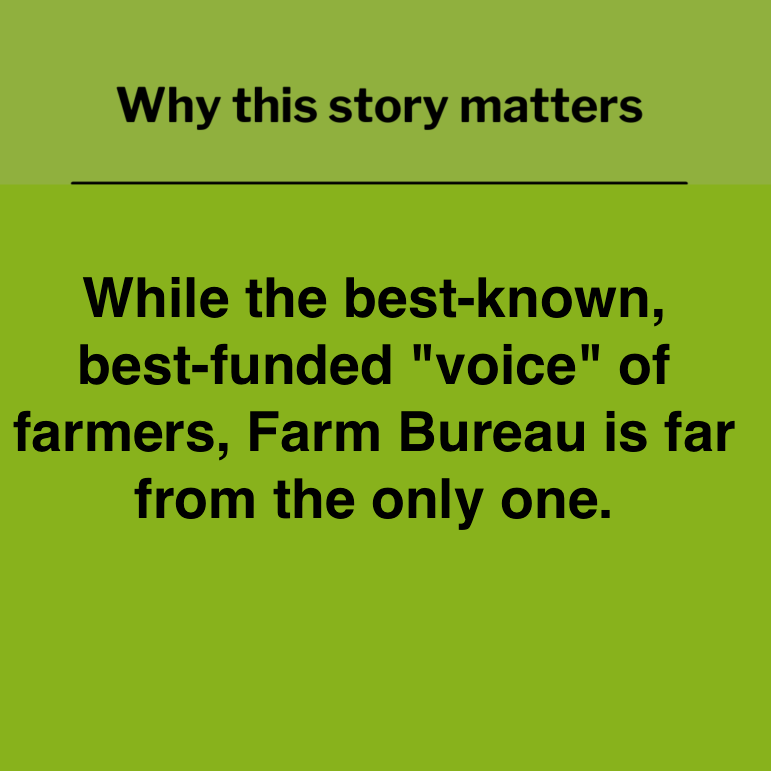
By the time policy proposals reach the annual conference — sponsored by ag giants including Bayer, Syngenta, John Deere and BASF — they’d been approved by voting members of county and state Farm Bureaus. Even within the AFBF, the delegates disagreed on which policy positions to take in the upcoming year.
These delegates’ decisions will likely be massively consequential. The AFBF is the most powerful institution representing rural Americans, and it spends more than anyone else on lobbying the federal government on agricultural issues.
The AFBF also wields massive influence on state legislatures, with the power to kill any agriculture bill they want, according to some of its political opponents. While agreeing with AFBF here and there, some smaller groups have distanced themselves from the organization, convinced it doesn’t represent their interests.
One of those groups is Ranchers-Cattlemen Action Legal Fund United Stockgrowers of America. It’s aligned with AFBF on some topics, such as land and water rights. But on issues where the interests of family farmers contradict corporate interests, such as how to reform a concentrated market, “we find the Farm Bureau to lean heavily towards corporate interests,” Bill Bullard, the R-CALF USA CEO, said.
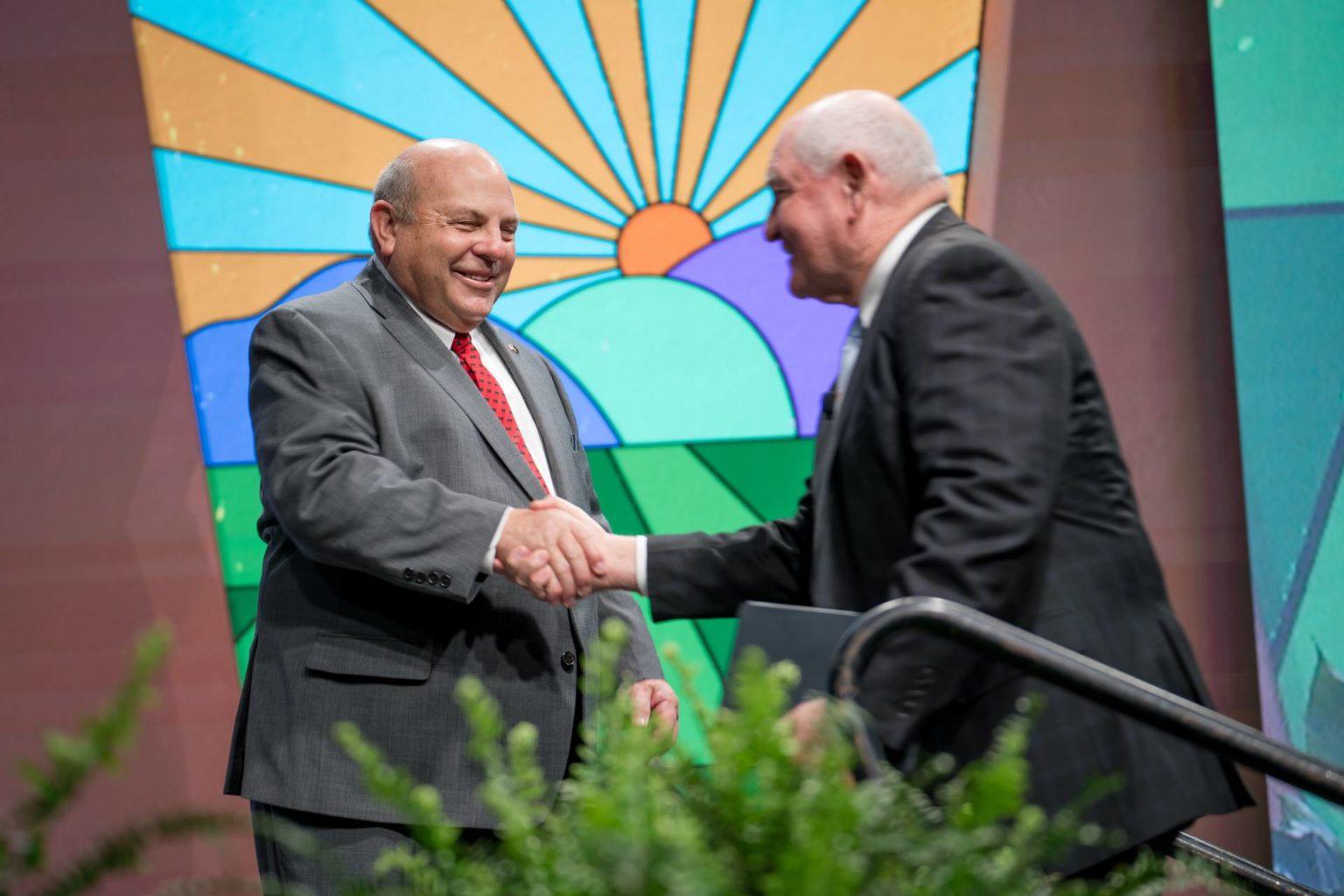
AFBF said it represents all kinds of farms: livestock and vegetable, large and small, organic and conventional.
“When you have an organization that’s as diverse as ours, there are going to be divergent opinions,” said Sam Kieffer, the AFBF’s vice president of public affairs. “And when you have an organization as large as ours, you will have folks, who are good folks, who disagree on certain issues.”
Many Farm Bureau members have seen the AFBF work on their behalf. Dustin Cowell, a 30-year-old, 8th-generation cattle rancher in Arkansas, started going to collegiate Farm Bureau meetings while attending the University of Arkansas, mostly for the free pizza.
But when his home county Farm Bureau chapter invited him to join the board, he quickly got involved in pushing for policies that would benefit his small, 30-cow operation. He thought the U.S. Department of Agriculture’s Farm Services Agency should raise the limit on the loans it offered to beginning farmers.
He wasn’t the only person with the idea. But he was excited when his fellow county board members approved the proposal, and then the board of the Arkansas Farm Bureau, and eventually the delegates at the 2018 annual convention.
The Farm Services Agency increased the loan limit later the following year.
But some former members don’t believe the process is as democratic as some believe.
Iowa hog farmer Chris Peterson was on his county Farm Bureau board in the 1980s and ‘90s. In 1998, pork prices hit historic lows as several meatpacking plants closed or reduced processing capacity. Peterson had to take a loan out to cover the cost of upkeep for his hogs. He and his wife took jobs off the farm to stay afloat.
Peterson, placing the blame for the collapse on an increasingly consolidated livestock market, became frustrated with the Farm Bureau’s lack of action against concentrated animal feeding operations, or CAFOs, and meatpacking companies.
“There were three or four of us who came at things in a different way,” he said. “The ones speaking the Farm Bureau language were the ones who advanced into the regional and state Farm Bureaus.”
He broke off from the organization in 2000 and started a local Farmers’ Union chapter, where he has held leadership positions ever since. He sold off his herd shortly after and now raises about 30 Berkshire hogs.
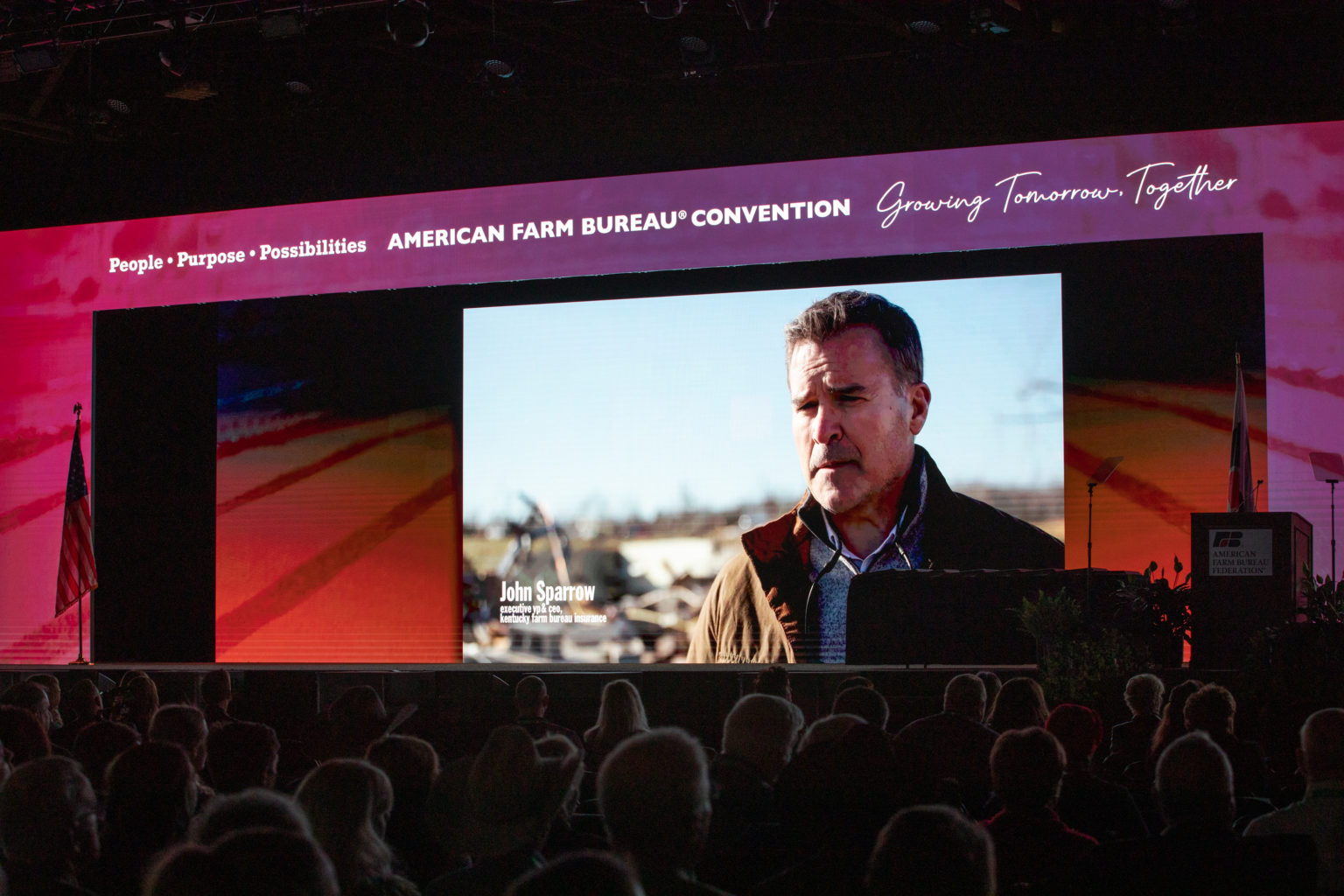
Some small farmers like Peterson argue CAFOs, which pack hundreds or thousands of animals in closed barns, damage the environment and drive down property values in the area.
But CAFOs are key to the success of large meat companies — a handful dominate the industry, including Tyson, JBS and Smithfield — as the facilities minimize the cost per head of raising animals and maximize profit margins.
Livestock operations legally defined as CAFOs are subject to more regulations than smaller or open-air facilities. The AFBF opposes regulating air pollution from CAFOs and other livestock operations, as well as changing the definition of a CAFO to encompass more livestock operations than the current standard.
When asked about criticism that the AFBF prioritizes the needs of industrial agriculture over family farms, Kieffer cited a USDA statistic stating that 98% of farms are family-owned.
Small family farms, defined as bringing in less than $350,000 per year, make up 47.7% of all farms and represent about 20% of national production.
“There are folks who want to create a division between large farms and other farms, and at the end of the day, the Farm Bureau is a place for all,” Kieffer said. “We represent all of them, and we have policies on a whole swath of issues.”
Divisions on how to solve a concentrated market
Outside the AFBF, organizations such as the Farmers’ Union seek to represent those of the country’s 3 million farmers who want to see American agriculture radically changed and view their powerful cousin as an obstacle to progress.
The National Farmers’ Union, the smaller, self-described “progressive” counterpart to the AFBF, has chapters around the country, but the AFBF overpowers it in terms of membership and money. The union has about 200,000 members — a fraction of the AFBF’s reported 6 million (non-farmers are invited to apply). The union’s lobbying budget is also much smaller: It spent $180,000 on federal lobbying last year compared to the AFBF’s $2 million, according to OpenSecrets.
Often, the AFBF butts heads with the National Farmers’ Union and other organizations over trade and market issues.
One clash involves the Cattle Price Discovery and Transparency Act, a bipartisan-supported U.S. Senate bill aimed at combating consolidation and low prices in the cattle industry.
It would augment reporting requirements for livestock sales, raise penalties for law-breaking meatpacking companies and, most controversially, would force meatpackers to purchase a minimum percent of cattle on the cash market.
As of 2017, half of all livestock were sold via production contracts, which allow meatpackers to purchase livestock at a predetermined price. From 1997 to 2017, the percent of cattle sold under contracts nearly doubled as the number of cattle sold at auction decreased.
The four beef companies who control up to 85% of the market — Cargill, JBS, National Beef and Tyson Foods — are currently embroiled in lawsuits alleging the companies conspired to drive down cattle prices.
The legislation carries the promise of meat processors paying more to cattle ranchers.
In January, AFBF delegates voted to oppose the cash market part of the legislation.
“We support the majority of this legislation, but we cannot support mandatory cash sales,” Zippy Duvall, the AFBF president, said in a Jan. 21 press release. “We are committed to working with the sponsors of the bill to make revisions to ensure it aligns with the priorities outlined by our membership.”
Groups like R-CALF USA have sought these market reforms and more for years but faced opposition from conservative lawmakers who prefer a hands-off approach to livestock pricing. The National Farmers’ Union also voiced support for the bill.
“We fight against the American Farm Bureau’s persistent efforts to achieve the failed free trade model for cattle and beef,” R-CALF’s Bullard said. “We have been trying to reform trade policy unsuccessfully for over 20 years. The American Farm Bureau is a key reason for that because they have so much influence in Congress.”
A fight over high-tech livestock tracing, and a potentially lucrative market
Another battle involves the electronic tagging of cattle, which small farm advocates claim could be a boon for giant livestock operations and meatpacking companies.
A pending USDA rule would require ranchers to use radio frequency identification, or RFID, ear tags on all cattle destined for interstate commerce. R-CALF USA and the Farm and Ranch Freedom Alliance, a Texas-based organization advocating for small farmers and ranchers, are on one side; AFB the other.
The RFID tags are a higher-tech version of the traditional plastic tags, tattoos, or brands used to identify cattle. RFID tags, commonly used in Europe, would allow veterinarians and ranchers to quickly identify and isolate animals in the event of a disease outbreak.
The USDA has argued the tags would reduce the risk of costly disease outbreaks in livestock. Because RFID tags are the standard in other countries, international demand for American beef would likely increase if the U.S. improved its animal tracing program, the USDA found in a 2009 cost-benefit analysis of the program.
Judith McGeary, founder and executive director of the Farm and Ranch Freedom Alliance, argued the program is intended to bolster export markets for American meat, a priority for large meat companies.
On the other hand, small farmers who focus on local sales have no stake in international markets, she said.
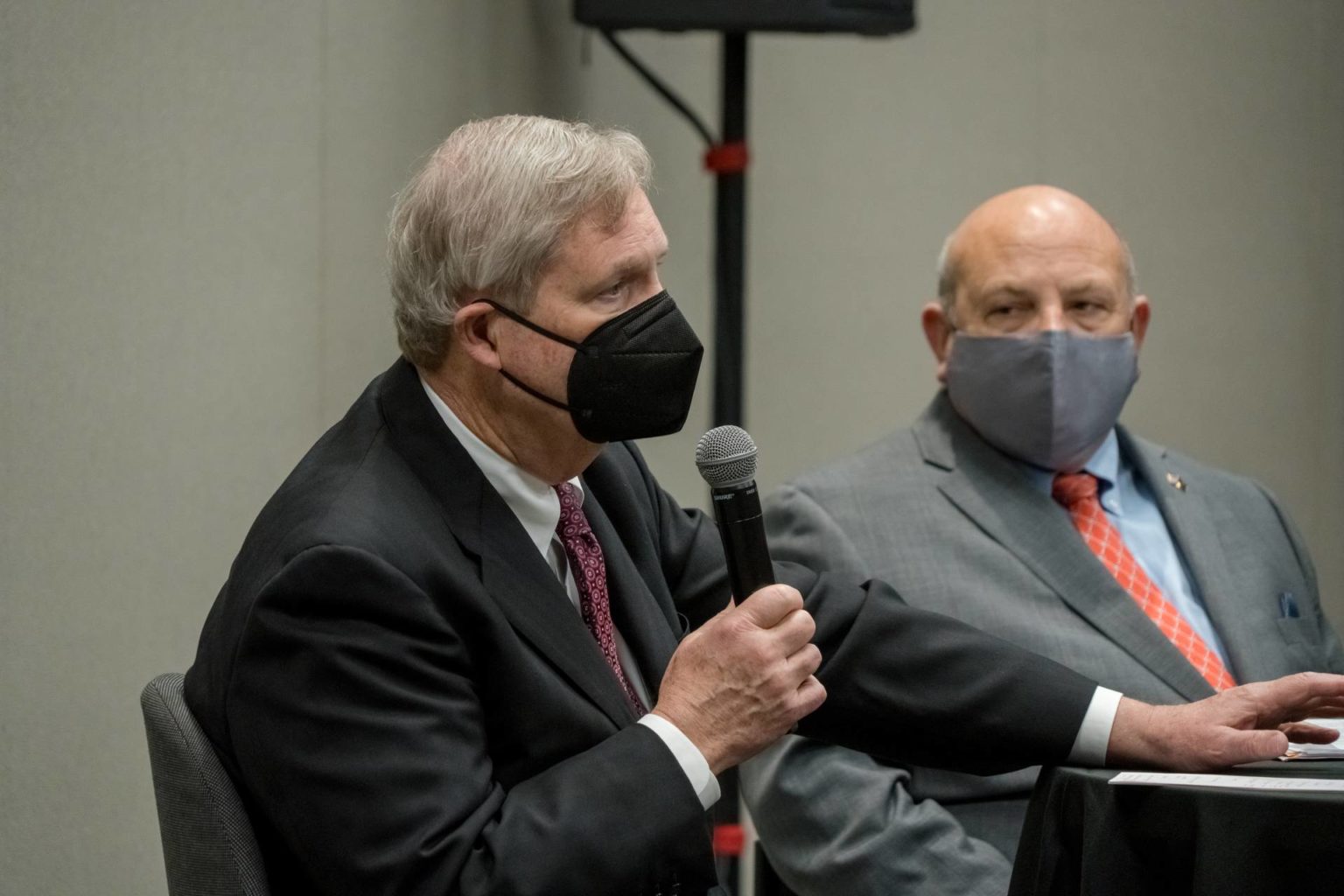
Purchasing and employing the tags and the related equipment would be a burden for small farmers, who are already struggling with low cattle prices, McGeary said. For large operations with bigger budgets, the cost of implementing RFID tags would be less of a burden, she argued.
“You have this double whammy of very, very heavy burdens on small farms,” she said, “and none of the supposed benefits coming down to them.”
In a comment submitted to the USDA, the AFBF expressed support for the implementation of a mandatory livestock identification program. It urged the federal government to provide tags and equipment free of charge.
But after receiving pushback from groups like R-CALF USA and the Farm and Ranch Freedom Alliance, in March 2021, the USDA delayed implementation of mandatory RFID tagging until a formal rulemaking process is completed.
Power in state capitols as well
State-level Farm Bureaus also wield a lot of influence, in part because few other organizations in the agriculture world have such a wealth of resources to devote to lobbying state legislatures, said Kendra Kimbirauskas, the director of agriculture and food systems for State Innovation Exchange, which provides policy resources to progressive state lawmakers on a variety of topics.
Because state legislatures often consist of part-time lawmakers, most of whom don’t have enough staff to perform research on all of the topics and bills the legislators must vote on, lawmakers often turn to industry groups like the Farm Bureau for advice, Kimbirauskas said.
With the Farm Bureau representing millions of farmers, it can be politically dangerous for lawmakers to publicly position themselves in opposition to the group, said Peterson, the Iowa Farmers Union board member.
AFBF’s Kieffer said the power to inform state and federal matters comes from the Farm Bureau’s policy making process, which allows his team to represent farmers from around the country.
“When our team walks into a congressional office or engages in a conversation, it’s not Sam Kieffer or a member of my staff,” he said. “It’s the voice of folks from back home who are having that conversation. We just have the privilege of relaying that conversation.”
Organic farmers push to be heard — inside and outside Farm Bureau
Tim Matis first joined the Farm Bureau 40 years ago for insurance. As a dairy farmer in upstate New York, he didn’t know that the Farm Bureau was anything more than an insurance company.
Farm Bureau members got a discount at the local farm supply store. When the store shut down, he canceled his membership.
That changed a few years ago when Matis, in his mid-60s at the time, enrolled in college classes in an attempt to improve his dairy’s financial situation. During a political science course, an interest in lawmaking and lobbying bloomed, and he learned about the Farm Bureau’s role in agriculture policy.
When he became an organic dairy farmer, he didn’t see the Farm Bureau advancing many policies prioritizing producers like him. He decided the best course of action was to get involved in the local Farm Bureau and propose the policies himself.
He wasn’t alone in his observation. McGeary, of the Farm and Ranch Freedom Alliance, said she’s seen the Farm Bureau fight policies that differentiate between organic and conventional farms.
McGeary advocated for a bill in Texas’s 2021 legislative session that created an “On-the-Ground Conservation Program” to provide education, technical assistance and outreach to farmers implementing certain practices to improve soil health.
Many progressive groups consider the soil health practices — including cover crops, no- or low-till farming methods and rotational grazing — to be cornerstones of organic, sustainable, or regenerative agriculture.
But McGeary said the Texas Farm Bureau made it clear that it opposed those words — organic, sustainable or regenerative — being included in the text of the legislation, even though the organization supported the bill otherwise.
Billy Howe, the Texas Farm Bureau’s associate government affairs director, said it opposed the inclusion of those terms because there are no agreed-upon definitions.
The AFBF Policy Book states, “When considering sustainable agriculture, there is only one constant and that is agriculture is only sustainable when it is profitable.”
Other definitions of sustainable agriculture focus on the health of the environment and on reducing the long-term impact of intensive agriculture.
Howe said the state agency responsible for implementing the soil health bill and other programs related to environmental sustainability should be responsible for defining the terms.
Texas Gov. Greg Abbott signed the “On-the-Ground Conservation Program” into law in May 2021, with the support of the Texas Farm Bureau and the Farm and Ranch Freedom Alliance, and without use of the words “organic,” “sustainable,” or “regenerative.”
In New York, Matis felt that the rules for qualifying as an organic dairy needed to be clarified and tightened — it was too easy for dairies to call themselves organic while engaging in practices that went against the purpose of being organic. That pushed the quality and the price of organic milk down, he said.
At his county Farm Bureau meeting, he suggested it push the USDA to reconsider the Origin of Organic Livestock Rule. That would achieve the reforms Matis sought.
The AFBF had previously and successfully lobbied against the rule, which had been delayed several times. But Matis and other Farm Bureau members who ran organic dairies were able to influence the Farm Bureau’s position.
His proposal was approved by the county and state farm bureaus, and ultimately by delegates at the annual convention. The rule was reopened for public comment in July 2021.
“The organization isn’t going to go away,” Matis said. “I think that’s why organic farmers should get involved.”
The supervising editor is Christopher Leonard of Watchdog Writers Group.

